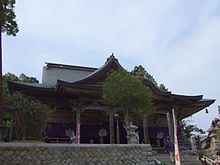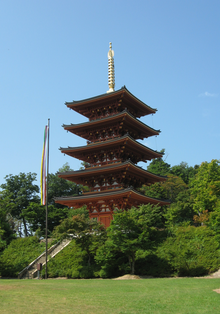Nariai-ji
The Nariai-ji ( Japanese. 成 相 寺 ) is a Buddhist temple in the community of Miyazu , Kyoto Prefecture in Japan . The temple is associated with the Shingon sect. The main portrait of the temple is a statue of the Shō- Kannon . The Nariai-ji is the 28th temple of the Saigoku pilgrimage route ( 西 国 三十 三 箇 所 , Saigoku sanjūsankasho ).
overview
There is no reliable historical evidence of the early days of Nariai-ji. The temple tradition reports that the monk Shinno founded the temple in 704. The main portrait of the Nariai-ji is a so-called migawari ("self-sacrificing") Kannon. A legend also handed down in the Konjaku Monogatarishū collection reports that a monk who was on the verge of starvation ate a dead wild boar in a severe winter only to discover later that it was the transformed statue of Kannon. The statue is also known as Bijin -Kannon and is only shown every 33 years.
The temple grounds are depicted on a scroll of Sesshū Tōyō from 1400, which is now in the Kyōto National Museum. Today's main hall of the temple dates from 1779. In 2005 the temple grounds were expanded to include a five-story pagoda . A wooden statue of Jizō from the Heian period and the iron trough of the hand washing station are important cultural assets of Japan . The Nariai-ji sankei mandala from the Muromachi period should also be mentioned.
Pilgrimages to Nariai-ji are often combined with visits to the Amanohashidate spit , which is located below Mount Nariai-san. Amanohashidate is one of the three most beautiful landscapes in Japan .
literature
- Patricia Frame Rugola: The Saikoku Kannon Pilgrimage Route. Dissertation, Ohio State University, 1986.
- Valeria Jana Schwanitz and August Wierling: Saigoku. On the way in Japan's western lands. Manpuku-Verlag, Potsdam 2012, ISBN 978-3-9815168-0-7 .
Web links
- Official Website (Japanese)
Coordinates: 35 ° 35 ′ 43.6 ″ N , 135 ° 11 ′ 14.5 ″ E

